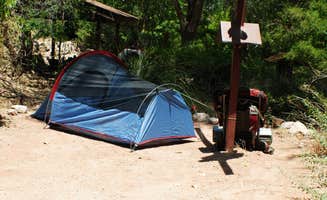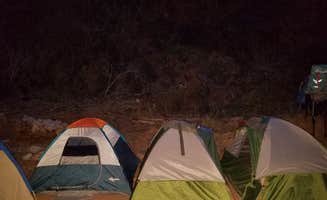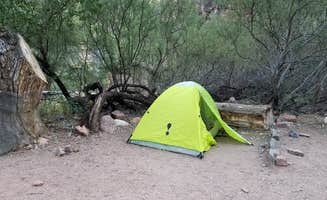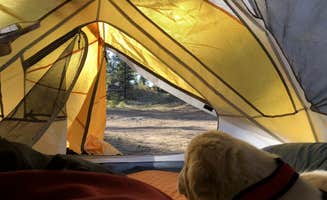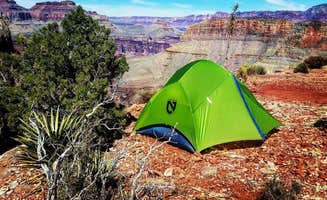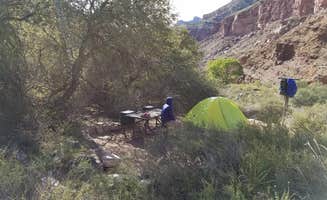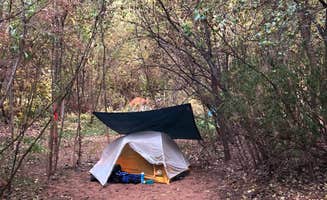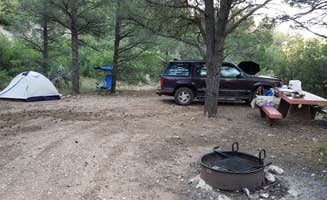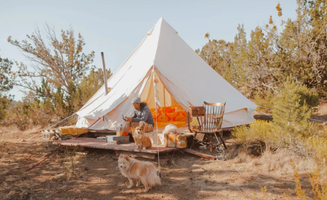Tent campsites near Grand Canyon, Arizona range from primitive backcountry sites to accessible roadside spots at elevations between 4,000 and 7,000 feet. Temperature fluctuations are extreme, with summer daytime temperatures exceeding 100°F at lower elevations and winter nights dropping below freezing. Most dispersed camping areas near the park require visitors to carry in all water and supplies while following strict regulations about waste management.
What to do
Short hikes from camp: Forest Service Road 305 offers convenient access to nearby trails. "We took a walk around and the forest is beautiful," notes one camper, highlighting the natural surroundings available without venturing far from your tent.
Creek relaxation: At Cottonwood Campground, visitors can cool off in the nearby water. "Our site was next to the creek and we quickly found our way there and took a nap on a large flat rock listening to the water falling over the rocks nearby," shares one hiker who enjoyed the natural amenities.
Wildlife observation: Forest Road 305 provides opportunities to spot local fauna. "We had a huge bull elk with his cows walk right past our camp," reports one visitor who appreciated the natural encounters while camping outside the park boundaries.
Visit the canteen: At Phantom Ranch, campers can purchase supplies and refreshments. "Inside the canteen you can purchase drinks (alcoholic and non), hiking essentials (toothbrush, sunscreen, salve, etc) and a selection of souvenirs. They even have a little library of books to read, and games that you can borrow and play," describes one visitor.
What campers like
Isolation from crowds: At Forest Service Road 328 Dispersed, campers appreciate the privacy. "Our spot was very isolated had a great sunset and was very quiet," one reviewer notes, describing the appeal of camping away from designated campgrounds.
Ranger programs: Educational opportunities enhance the camping experience at certain sites. "The daily Ranger talks are interesting and informational," reports a camper at Bright Angel Campground, adding value to the backcountry experience.
Early morning wildlife: Dawn provides prime animal viewing opportunities. "We car camped here for two nights while we did day trips into the park. It's a great way to avoid all the campers and noise inside the park," explains one visitor who encountered elk at their Forest Service Road 328 site.
Shade options: At Havasupai Gardens Campground, the natural vegetation provides relief from the sun. "There is plenty of shade, good drinking water, and modern out house bathrooms," mentions a reviewer, highlighting the practical benefits of this mid-canyon location.
What you should know
Permits required: For backcountry sites like Bright Angel Campground, advance planning is essential. "Permits ARE required and ENFORCED STRICTLY: do NOT hike down expecting to find open space without one. The permitting process is a whole other thing," cautions one experienced visitor.
Wildlife precautions: Small animals are persistent at many canyon tent sites. "Watch out for ringtails, mice, and ravens; they're bold and persistent. Keep all food inside the ammo cans," advises a camper at Bright Angel Campground.
Park entry timing: For dispersed campers planning day trips, timing matters. "If you stay here on the weekends and plan to go to the park, get up early. The lines are insane!" warns a Forest Road 328 camper about South Rim access.
Water availability: Seasonal variations affect water sources. "When we were there they didn't have running water to just fill up from. Very hot on the way to this camp site as there is not much cover on the trail," notes a Cottonwood Campground visitor, emphasizing the importance of checking current conditions.
Tips for camping with families
Pack extra lighting: Tent camping with children requires proper illumination. "Camp spots are a bit close, but they are covered which is a nice relief from the sun," explains a Havasupai Gardens camper, highlighting the sheltered picnic tables that provide family gathering spaces regardless of weather.
Consider spacing needs: For families seeking more room, certain campgrounds offer better layouts. "The campgrounds each have tent spots and covered picnic tables. There are pit toilets and running water available," notes a visitor to Havasupai Gardens, detailing amenities important for family camping.
Wildlife education opportunities: Animal sightings create memorable experiences for children. "We saw deer from our site. It's worth the stop over," shares a Havasupai Gardens camper, pointing out the educational value of wildlife encounters.
Emergency communications: Families should note communication limitations. "There's no cell service here. Plan to disconnect entirely. Emergencies are serious as this is a very remote area," warns a camper at Granite Rapids Area Campsites, emphasizing the importance of proper preparation.
Tips from RVers
Road conditions check: For RV access to dispersed sites, vehicle clearance matters. "Road was a little bumpy and not suggested for passenger cars!" cautions a Forest Road 328 visitor, indicating the importance of checking current road conditions before attempting access with larger vehicles.
Campsite selection strategy: Arriving early helps secure suitable spots for larger vehicles. "There's plenty of spots, we never ran into not finding a spot and we got in pretty late," reports a Forest Service Road 328 camper, though site availability varies by season and visitation levels.
Distance considerations: Proximity to park entrances affects day trip planning. "Great spot, easy access and 6 miles from the South entrance to the Canyon," notes one camper about Forest Road 328, providing useful information about travel distances when planning excursions from camp.
Seasonal timing: Weather patterns influence RV camping experiences. "We got there late easy to find follow google already dispersed spots some small some large...fyi it's a loop," shares a Forest Road 305 visitor, highlighting the importance of researching site layouts before arrival with larger vehicles.


